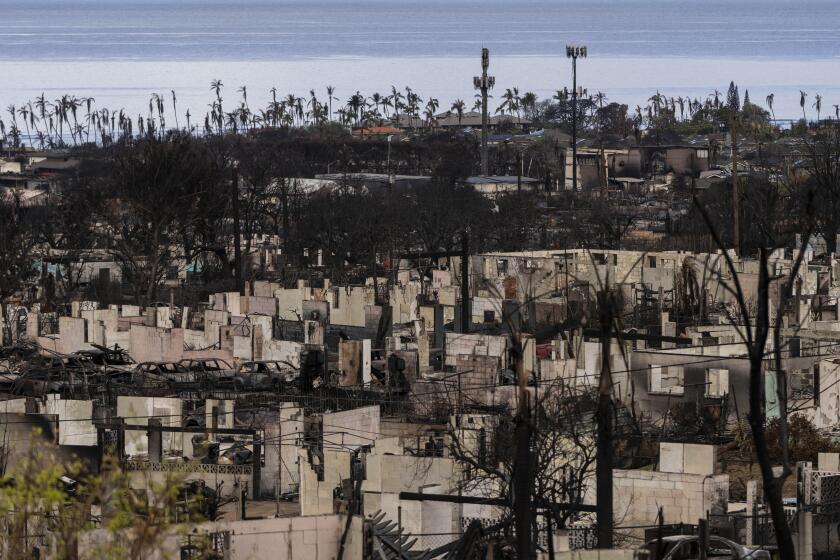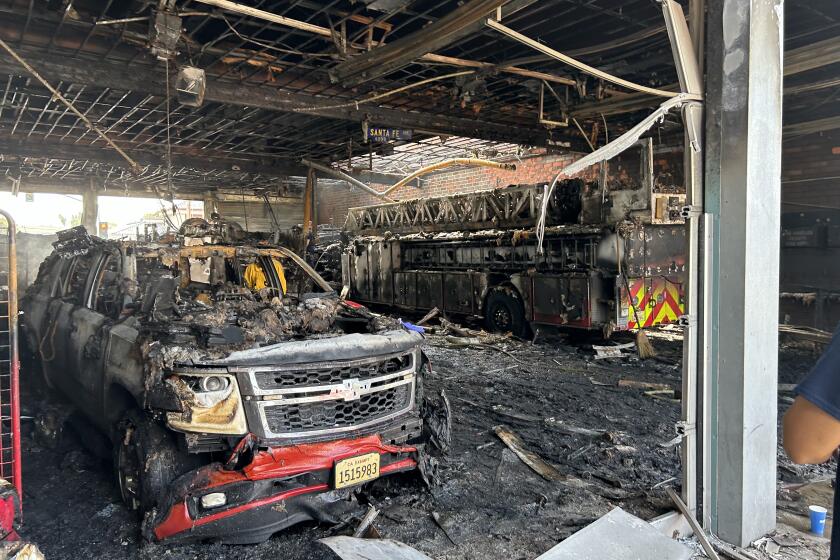Topanga Fire Plan Isn’t Flying
The fire question in brushy Topanga Canyon parrots the earthquake question throughout Southern California: not whether the Big One will come, but when. Moreover, what can be done about it?
Some residents are offering an answer to the second part of the question: They are seeking private funds to buy two $22-million firefighting “Super Scooper” airplanes, which they would then donate to the county.
The Los Angeles County Fire Department and Board of Supervisors say they don’t want the planes and that there are more effective ways to fight fires in the Santa Monica Mountains. But residents are unconvinced.
Tony Morris, who founded the fledgling Aerial Fire Protection Assn., has negotiated, pressed and all but begged the county and state to buy the planes, which he believes could save Topanga Canyon’s melange of 5,000 woodsy bungalows and high-priced estates from a fast-moving fire.
A former documentary film writer, Morris hopes the money can be raised by local entertainment industry professionals, who are scared as all getout--but don’t want to actually get out of the canyon.
“This idea started with self-interest,” Morris said. “I don’t want to burn to death.”
The association has not raised any money nor approached the insurance companies, foundations and entertainment companies it believes would be primary benefactors. Morris was reluctant to say whom he would target but said that Steven Spielberg and Kate Capshaw’s recent donation of $12 million to keep some mountain stables open to the public demonstrates the means and generosity of some residents in the Santa Monicas.
Heavy smoke damaged Morris’ home in the 1993 Topanga Canyon fire, which killed three people and destroyed more than 300 homes in Calabasas, Malibu and Topanga and inspired the county to lease the Super Scoopers. The fire stopped 150 feet short of Morris’ house. His neighbors and other Topangans rebuilt over the ashes of theirs.
“A small percentage of people eventually decide the danger is too much, but most of us stay because we love the area so much,” Morris said. “No matter why we live here, if the county allows people to live here, it’s got to protect us.”
The Aerial Fire Protection Assn. made a video last year vaunting the high-capacity, Canadian-made planes and depicting the desperation of residents who live amid the touchwood in the canyons. The group also proposed a fire protection district to raise taxes for the Super Scoopers.
The county already leases two of the planes during the traditional fire season, from mid-September to December.
Bob Cavage, president of the Aerial Fire Protection Assn., said that is not enough. The imminent big one is a “coming war,” he said, and the county should be prepared to outgun the conflagration.
“In a warehouse building, you wouldn’t turn the sprinklers on three months and leave them off nine,” Cavage said. “With 10 million people in greater Los Angeles, wouldn’t it be wise to deploy a full, functional arsenal year-round?”
The fixed-wing Canadair CL-415 Super Scooper fills its tank in as few as 16 seconds by skimming across a body of water--in Southern California, usually the ocean. It dumps 1,600 gallons at a time and can circle back at 170 mph.
In addition to the leased Super Scoopers, the county has a stable of two new $12.5-million Firehawk helicopters--a modified version of the military’s Black Hawk--and five smaller choppers. The county also leases two 2,000-gallon-capacity Erickson Air-Crane helicopters.
The Firehawks have proved their value but were a hard sell, even in fatter times for the county, according to Supervisor Zev Yaroslavsky.
“I was very skeptical about those until the fire chief convinced me it was better to buy them than to lease or purchase any other piece of equipment, including Super Scoopers,” Yaroslavsky said.
While the Topanga group contends purchase price is the one thing in the way of owning Super Scoopers, Yaroslavsky and fire officials say other costs, such as maintenance and crew salaries, make the association’s proposal dubious.
County Fire Chief P. Michael Freeman said that, cost aside, the Super Scooper might not be the best choice for the county’s widely varying terrain. It can’t be used at night and is not as precise as a helicopter.
The Super Scooper has other detractors. The California Department of Forestry and Fire Protection, like other agencies, uses converted Korean War-era military planes to fight fires.
Karen Terrill, public information officer of the department, said the state cannot justify buying the Canadian planes when the federal government gives away the military planes. Converting a plane to fight fires costs about $2.2 million. For about the cost of two Super Scoopers, the department outfitted its entire fleet of 23 air tankers.
Freeman and Yaroslavsky insist they are not at odds with the Aerial Fire Protection Assn., and say that handing them an eight-figure check would not be enough to put Super Scoopers in the budget.
“If we had $50 million on the table and the objective was to fight fires the very best we can, quickly and decisively from the air, my experience tells me more heavy-capacity helicopters make more sense than buying Super Scoopers,” Freeman said.
The two Super Scoopers the county does lease have a mixed record of fighting fires in their seven years in Los Angeles County. They doused a 1999 Thanksgiving Day blaze in Santa Monica in three drops. They snuffed out a 1996 Westlake Village fire with Santa Ana winds blowing but were not much help against higher winds in a Calabasas fire a week earlier.
Still, the Aerial Fire Protection Assn. contends the Super Scoopers are needed.
“We don’t want to put a burden on the county, but we do need these planes,” Cavage said, pointing out that Super Scoopers are used in Minnesota, Canada and France.
Yaroslavsky is not buying it.
“Minnesota’s biggest mountain is a molehill,” he said. “Europe is not L.A. The county owning a plane that will sit for most of the year is like a Nebraskan owning a boat.”
More to Read
Start your day right
Sign up for Essential California for news, features and recommendations from the L.A. Times and beyond in your inbox six days a week.
You may occasionally receive promotional content from the Los Angeles Times.






